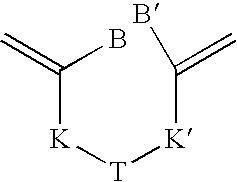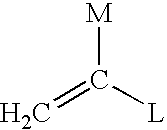Process for transforming the end groups of polymers
- Summary
- Abstract
- Description
- Claims
- Application Information
AI Technical Summary
Benefits of technology
Problems solved by technology
Method used
Image
Examples
example 1
Preparation of cyanomethyl 2-carboxyethyl trithiocarbonate
[0133]3-Mercaptopropionic acid (5.3 g, 0.05 mol) was added within 10 minutes to a stirring suspension of potassium carbonate (7.0 g, 0.051 mol) in acetonitrile (40 mL) at room temperature. The reaction mixture was added carbon disulfide (3.8 g, 0.05 mol). The resulting yellow mixture was kept stirring for two hours and then added chloroacetonitrile (3.78 g, 0.05 mol). The resulting mixture was allowed to stir at room temperature for further one hour. Water (50 mL) was added, the yellow aqueous solution was acidified with dilute hydrochloric acid until pH˜2 and extracted with diethyl ether (50 mL×2). The organic layer was dried over anhydrous magnesium sulfate. After removal of solvent, the product cyanomethyl carboxyethyl trithiocarbonate was obtained as a yellow solid (6.4 g, 58% yield) after column chromatography (silica-gel; ethyl acetate: n-hexane 3:7 as solvent). 1H NMR (CDCl3) δ 2.85 (t, 2H, HOOCCH2); 3.65 (t, 2H, CH2S)...
example 2
[0134]Preparation of poly(butyl acrylate) 2-carboxyethyl trithiocarbonate A solution of the RAFT agent cyanomethyl 2-carboxyethyl trithiocarbonate (300 mg) and AIBN (2.2 mg) in butyl acrylate (6 mL) and ethyl acetate (4 mL) was degassed through three freeze-evacuate-thaw cycles and heated at 60° C. for 5 hours. Removal of the volatiles under reduced pressure afforded a yellow polymer (1.7 g, 32% conversion) of Mn=990 and Mw / Mn=1.23. The methylene hydrogens of the 2-carboxyethyl group appeared at 2.8 and 3.5 ppm in the proton NMR. The end group methine hydrogens [—CH(CO2Bu)—SCS] appeared at 4.8 ppm.
example 3
[0135]Preparation of polystyrene 2-carboxyethyl trithiocarbonate A solution of the RAFT agent cyanomethyl 2-carboxyethyl trithiocarbonate (250 mg) and Vazo-88® initiator supplied by DuPont Company of Wilmington, Del. (8 mg) in styrene (8 mL) and ethyl acetate (2 mL) was degassed through three freeze-evacuate-thaw cycles and heated at 90° C. for 16 hours. Removal of the volatiles under reduced pressure afforded a yellow polymer (4.1 g, 51% conversion) of Mn=2350 and Mw / Mn=1.07. The methylene hydrogens of the 2-carboxyethyl group appeared at 2.8 and 3.5 ppm in the proton NMR. The end group methine hydrogens [—CH(Ph)—SCS] appeared at 4.6-5.0 ppm.
PUM
| Property | Measurement | Unit |
|---|---|---|
| Temperature | aaaaa | aaaaa |
| Temperature | aaaaa | aaaaa |
| Temperature | aaaaa | aaaaa |
Abstract
Description
Claims
Application Information
 Login to View More
Login to View More - R&D
- Intellectual Property
- Life Sciences
- Materials
- Tech Scout
- Unparalleled Data Quality
- Higher Quality Content
- 60% Fewer Hallucinations
Browse by: Latest US Patents, China's latest patents, Technical Efficacy Thesaurus, Application Domain, Technology Topic, Popular Technical Reports.
© 2025 PatSnap. All rights reserved.Legal|Privacy policy|Modern Slavery Act Transparency Statement|Sitemap|About US| Contact US: help@patsnap.com



